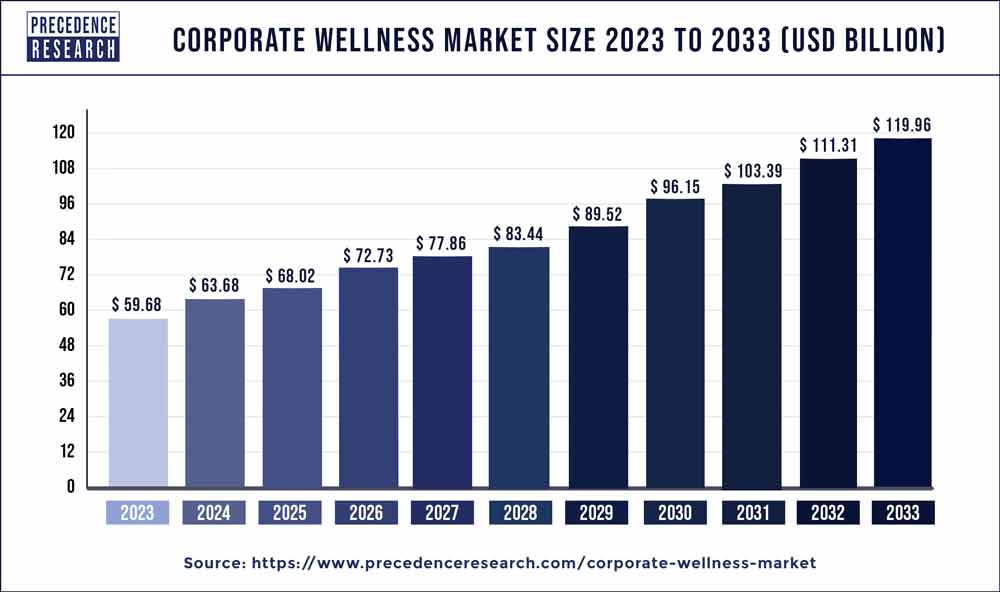The global corporate wellness market was valued at USD 59.68 billion in 2023 and is projected to reach approximately USD 119.96 billion by 2033, growing at a CAGR of 7.3%.
Corporate Wellness Market Key Takeaways
- North America accounted for over 40.47% of the total revenue share in 2023.
- The Asia Pacific region is projected to witness the fastest CAGR between 2024 and 2033.
- By Service, the health risk assessment segment dominated the market with a 21.44% share in 2023.
- By Category, the organizations/employers segment held the largest revenue share at 50.49% in 2023.
- By the Delivery Model, the onsite segment contributed more than 60.60% of the total revenue share in 2023.
- By End-use, large-scale organizations are expected to maintain the highest market share of 64.14% in 2023.
The Corporate Wellness Market focuses on programs and services designed to improve employee health and well-being, ultimately enhancing productivity and reducing healthcare costs for organizations. It encompasses various services such as health risk assessments, fitness programs, mental health support, and nutrition counseling. In 2023, the market was valued at USD 59.68 billion and is projected to reach approximately USD 119.96 billion by 2033, growing at a CAGR of 7.3%.
North America holds the largest revenue share, while the Asia Pacific region is expected to grow at the fastest rate. Key segments include onsite and offsite wellness programs, with large-scale organizations leading in adoption. The increasing emphasis on workplace wellness, rising healthcare costs, and the shift towards preventive healthcare are driving market expansion.
Sample Link: https://www.precedenceresearch.com/sample/1066
Key Drivers
Opportunities
- The increasing adoption of digital health solutions, including wearable devices and AI-driven wellness platforms, is creating new growth avenues.
- Rising corporate investments in employee well-being to improve productivity and reduce absenteeism are fueling market expansion.
- The growing emphasis on mental health and stress management is driving demand for holistic wellness programs.
- Expanding government initiatives and regulations supporting workplace wellness are encouraging businesses to implement structured programs.
- The rise of remote and hybrid work models has opened up opportunities for virtual wellness solutions and telehealth services.
Challenges
- High implementation costs and budget constraints can hinder small and medium-sized enterprises (SMEs) from adopting comprehensive wellness programs.
- Employee participation and engagement remain a challenge, as some workers may be reluctant to participate in wellness initiatives.
- Data privacy and security concerns related to digital wellness platforms can create hesitancy in adoption.
- Lack of standardized regulations across different regions can lead to inconsistencies in program effectiveness and compliance.
- Measuring the ROI (Return on Investment) of corporate wellness programs can be complex, making it difficult for organizations to assess their long-term benefits.
Regional Insights
The Corporate Wellness Market exhibits significant regional variations, with North America leading the market, accounting for over 40.47% of the total revenue share in 2023. The region’s dominance is driven by strong corporate investments in employee wellness, increasing healthcare costs, and widespread adoption of digital health technologies. Europe follows closely, with growing awareness of workplace wellness and government support for employee health initiatives.
The Asia Pacific region is expected to witness the fastest growth between 2024 and 2033, fueled by rapid urbanization, a rising working population, and an increasing corporate focus on employee well-being. Countries like China, India, and Japan are driving this growth due to their expanding economies and the growing prevalence of lifestyle-related diseases. In Latin America and the Middle East & Africa, the market is gradually expanding as businesses recognize the long-term benefits of employee wellness programs, although cost constraints and lack of awareness still pose challenges.
Don’t Miss Out: Solid Tumor Cancer Treatment Market
Market Key Players
- EXOS
- Vitality Group
- Privia Health
- Central Corporate Wellness
- Wellsource, Inc.
- SOL Wellness
- Truworth Wellness
- ADURO, INC.
- Well Nation
- Fitbit, Inc.
Recent News
Recent developments in the corporate wellness market highlight its significant growth and evolving focus areas. In November 2024, a report projected that the global corporate wellness market would expand from USD 64.31 billion in 2024 to approximately USD 130.03 billion by 2034, reflecting a compound annual growth rate (CAGR) of 7.35%. This growth is attributed to an increasing emphasis on employee health and wellness, with companies recognizing the benefits of such programs in reducing absenteeism and enhancing productivity. Technological advancements, including the integration of wearables, mobile apps, and AI into wellness programs, have made personalized wellness solutions more accessible.
Additionally, government initiatives across regions like the U.S., Europe, and Asia are encouraging businesses to invest in employee health. Regionally, North America continues to lead the market, while the Asia Pacific region is expected to witness the fastest growth between 2024 and 2033, driven by rapid urbanization and a rising working population. Key segments contributing to this growth include health risk assessments, fitness services, and mental health support, with large-scale organizations leading in adoption.
Market Segmentation
By Service
- Fitness
- Health Risk Assessment
- Health Screening
- Smoking Cessation
- Stress Management
- Nutrition & Weight Management
- Others
By Category
- Psychological Therapists
- Fitness & Nutrition Consultants
- Organizations/Employers
By Delivery Model
- Offsite
- Onsite
By End-use
- Large Scale Organizations
- Medium Scale Organizations
- Small Scale Organizations


